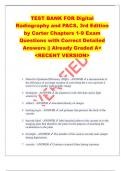Exam (elaborations)
TEST BANK FOR Digital Radiography and PACS, 3rd Edition by Carter Chapters 1-9 Exam Questions with Correct Detailed Answers || Already Graded A+ <RECENT VERSION>
- Course
- Institution
TEST BANK FOR Digital Radiography and PACS, 3rd Edition by Carter Chapters 1-9 Exam Questions with Correct Detailed Answers || Already Graded A+ <RECENT VERSION> 1. Detective Quantum Efficiency (DQE) - ANSWER a measurement of the efficiency of an image receptor i...
[Show more]



